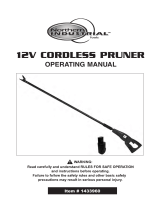
5
ENGLISH
(Original instructions)
Power tool use and care
Do not force the power tool. Use the correct •
power tool for your application. The correct
power tool will do the job better and safer at the
rate for which it was designed.
Do not use the power tool if the switch •
does not turn it on and off. Any power tool
that cannot be controlled with the switch is
dangerous and must be repaired.
Disconnect the plug from the power source •
and/or the battery pack from the power tool
before making any adjustments, changing
accessories, or storing power tools. Such
preventive safety measures reduce the risk of
starting the power tool accidentally.
Store idle power tools out of the reach of •
children and do not allow persons unfamiliar
with the power tool or these instructions
to operate the power tool. Power tools are
dangerous in the hands of untrained users.
Maintain power tools. Check for misalign-•
ment or binding of moving parts, breakage
of parts and any other condition that may
affect the power tools operation. If dam-
aged, have the power tool repaired before
use. Many accidents are caused by poorly
maintained power tools.
Keep cutting tools sharp and clean. • Prop-
erly maintained cutting tools with sharp cutting
edges are less likely to bind and are easier to
control.
Use the power tool, accessories and tool •
bits etc., in accordance with these instruc-
tions, taking into account the working condi-
tions and the work to be performed. Use
of the power tool for operations different from
those intended could result in a hazardous
situation.
Battery tool use and care
Recharge only with the charger specied by •
the manufacturer. A charger that is suitable
for one type of battery pack may create a risk of
re when used with another battery pack.
Use power tools only with specically •
designated battery packs. Use of any other
battery packs may create a risk of injury and
re.
When battery pack is not in use, keep it •
away from other metal objects, like paper
clips, coins, keys, nails, screws, or other
small metal objects, that can make a con-
nection from one terminal to another. Short-
ing the battery terminals together may cause
burns or a re.
Under abusive conditions, liquid may be
•
ejected from the battery; avoid contact.
If contact accidentally occurs, ush with
water. If liquid contacts eyes, additionally
seek medical help. Liquid ejected from the
battery may cause irritation or burns.
Service
Have your power tool serviced by a qualied •
repair person using only identical replace-
ment parts. This will ensure that the safety of
the power tool is maintained.
Additional safety instructions for pole
pruners
The intended use is described in this instruction
manual. Do not use the tool for purposes not
intended; for example do not use the tool to fell
trees. The use of any accessory or attachment or
performance of any operation with this tool other
than those recommended in this instruction manual
may present a risk of personal injury.
Wear close tting and protective clothing •
including a safety helmet with visor/goggles, ear
protectors, non-skid safety footwear, protective
bib trousers and strong leather gloves.
Always position yourself out of the path of
•
falling branches.
The safe distance between a branch to be •
felled and bystanders, buildings and other
objects is at least 2 1/2 times the length of the
branch. Any bystander, building or object within
this distance is at risk from being struck by the
falling branch.
Pre-plan a safe exit from falling trees or •
branches. Ensure the exit route is clear
of obstacles that would prevent or hinder
movement. Remember wet grass and freshly
cut bark is slippery.
Ensure someone is nearby (but at a safe •
distance) in case of an accident.
Do not use the tool while standing in a tree, on •
a ladder or on any other unstable surface.
Keep proper footing and balance at all times. •
Hold the tool rmly with both hands when the •
motor is running.
Do not let the moving chain contact any object •
at the tip of the guide bar.
Start cutting only with the chain moving at full •
speed.
Do not attempt to enter a previous cut. Always •
make a fresh cut.
Watch for shifting branches or other forces that •
could close a cut and pinch or fall into the chain.
















